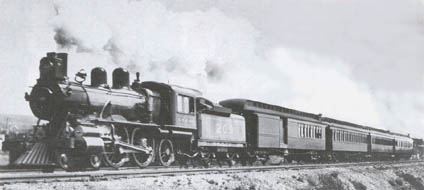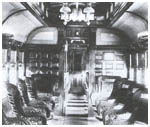
Volume 14
Number 15
Nov. 14, 1984
|
 |
Canadian Pacific and Canada Atlantic Railway Rivalry
Improved Running Times Between Montreal and Ottawa
By Dave Jones

Atlantic Type: Locomotive number 209 races on its way
to Ottawa, hauling what was advertised as "the finest equipped passenger trains in the world". To get
all possible speed from the engine that was possible, this type of locomotive was equipped with oversized
84-inch driving wheels.
Ever since the introduction of passenger train service and the
timetables which accompany it, there has been fierce competition between rival lines, but perhaps none so intense
as the battle between the Canada Atlantic Railway and the Canadian Pacific Railway in providing express passenger
accommodation between Montreal and Ottawa.
| |

Riding in Comfort: The smoking cars on the express
passenger trains between Montreal and Ottawa were equipped with revolving wicker chairs, convenient for
both conversation with fellow passengers or viewing the scenery.
|
As early as the winter of 1882, C.W. Spencer,
assistant superintendent of the CPR was in correspondence with C.C. Linsley, manager of the Canada Atlantic to
discuss what were felt to be foolishly-short scheduled times between the two cities.
Apparently no agreement was ever reached, for when the Canada Atlantic advertisements ran the next summer, they
advertised "four lightning express trains daily", the fastest of which covered the approximate 111 mile
(178 kilometer) distance from Montreal to Ottawa in three hours flat.
Not to be outdone, Canadian Pacific announced their summer arrangement as "The old line - always ahead -
Ottawa to Montreal in two hours and fifty-five minutes".
To further titillate the travelling public, it was pointed out that the CPR operated the "finest equipped
passenger trains in the world" and the "grandest drawing room cars in America".
Thus began a two-decade contest to provide the fastest and most luxurious service possible along
this popular corridor which reached its apex at the turn of the century, after both lines had acquired brand new
Atlantic-type steam locomotives.
The three CPR engines, numbers 209, 210, and 211, had a 4-4-2 wheel arrangement and were
specially-equipped with oversized 84-inch driving wheels, the largest ever employed by
the company, in order to get all the speed from them that was possible.
Their cabs had attractive lines, rounded-offat the corners without rivet heads or bolts and lined on
the interior with
wood.
The tenders were newly-designed with an exceptionally large capacity of 4,500 gallons (20,457 litres)
of water, sufficient for the Montreal to Ottawa run without a stop, and eight tons (7.2 metric tons) of coal,
enough for the round trip.
The consists of Canadian Pacific's express trains included various combinations of baggage, smoking, second and
first class cars and a parlor car.
All the coaches were lit by electricity, the incandescent globes being on the walls in second and first class
instead of near the ceiling, and their exteriors were finished in polished mahogany.
Passengers were surrounded by satin wood panels and columns, richly carved and ornamented; the observation
windows were hung with damask silk and the chairs upholstered in terra cotta plush.
By 1904, although the schedule had been reduced to two hours and fifteen minutes, most engineers were only
interested in putting distance between their marker lamps and the opposing railway's cow catcher, and times under
two hours were not uncommon.
It was around this time that the CPR's president, Lord Shaughnessy, is said to have called one of the locomotive
engineers to his office for a reprimand.
"They tell me that you've been racing with the Canada Atlantic", the president said gruffly.
"Yes sir", gulped the engineer, his gaze fixed to the floor.
"Well I won't stand for it", Shaughnessy replied. "There'll be no speeding on this railway".
And he dismissed the man with a wave of his hand.
"But", he called out as the engineer hurried from the room, "don't let the other guy win
either".
This CP Rail News article is copyright
1984 by Canadian Pacific Railway and is reprinted here with their permission. All photographs, logos, and
trademarks are the property of the Canadian Pacific Railway Company.
|
|